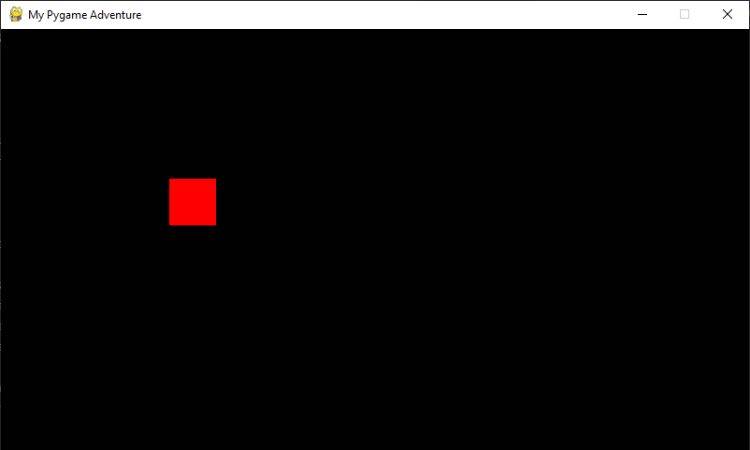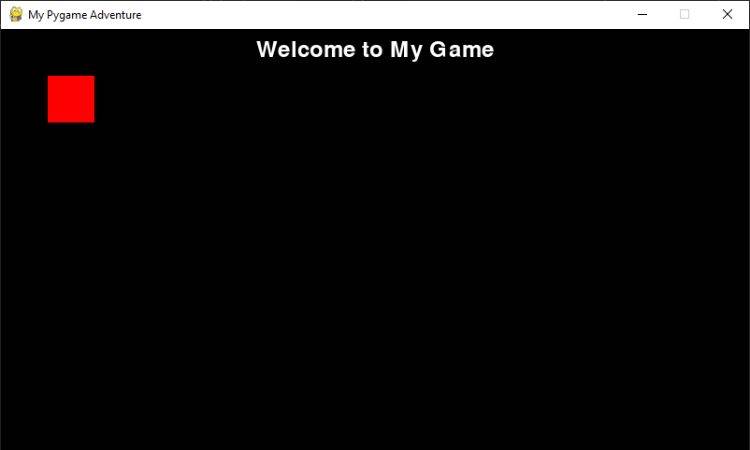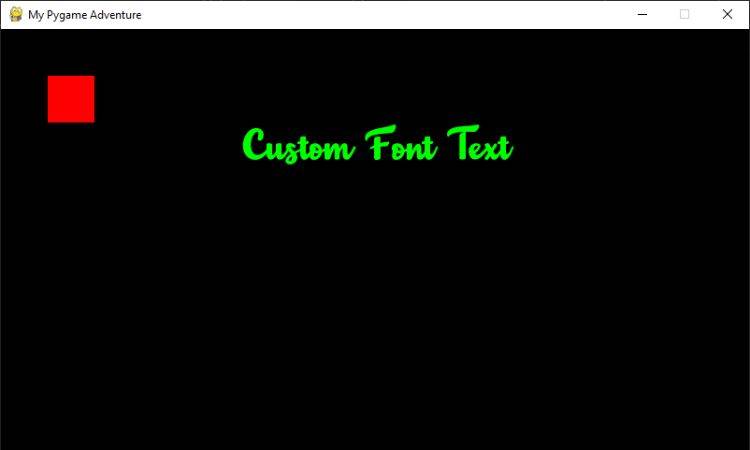Aesthetics play a crucial role in game development. Small details can affect how well your game captures the attention of players and immerses them in the game world. Custom fonts and text effects allow you to infuse personality and style into your game's interface, dialogue, and HUD elements.
Whether you're designing an adventure game, puzzle game, or any other, custom fonts and text effects can transform your project from basic to captivating.
Create a Simple 2D Game
Before diving into the world of custom fonts and text effects, create a basic 2D game foundation. For this example, craft a game with player movement using Pygame's features.
The code used in this article is available in this GitHub repository and is free for you to use under the MIT license.
To start, set up the game window. Pygame provides the pygame.display.set_mode() function to create a window that displays your game. You can also set a title for the window using pygame.display.set_caption().
import pygame
pygame.init()
# Set up display
width, height = 800, 600
screen = pygame.display.set_mode((width, height))
pygame.display.set_caption("My Pygame Adventure") Now, initialize the player object using the pygame.Rect() class. This class represents a rectangular shape, which you can use to represent characters and objects in 2D games.
# Initialize player
player = pygame.Rect(50, 50, 50, 50)
player_color = (255, 0, 0) The main game loop is the heart of your game, where all the action happens. It continuously checks for player input, updates the game state, and redraws the screen.
# Main game loop
running = True
while running:
for event in pygame.event.get():
if event.type == pygame.QUIT:
running = False
# Player Movement
keys = pygame.key.get_pressed()
if keys[pygame.K_LEFT]:
player.x -= 5
if keys[pygame.K_RIGHT]:
player.x += 5
if keys[pygame.K_UP]:
player.y -= 5
if keys[pygame.K_DOWN]:
player.y += 5
screen.fill((0, 0, 0))
# Draw the player
pygame.draw.rect(screen, player_color, player)
# Update the screen
pygame.display.flip()
pygame.quit() Here's the basic output so far:
Add Text to Your Game
To display text, start by loading a font using the pygame.font.Font() class. You can specify the font file and the font size:
# Load font
font = pygame.font.Font(None, 36) With the font loaded, you can now render and display text on the screen. The render() method of the font object takes the text, antialiasing setting, and color as arguments. You can then use the blit() function to draw the rendered text onto the screen.
# Main game loop
while running:
# Draw the player
# Render and display text
text = font.render("Welcome to My Game", True, (255, 255, 255))
screen.blit(text, (width // 2 - text.get_width() // 2, 10))
# Update the screen The output should look something like this:
Add Custom Fonts
While the default fonts work well, using custom fonts can significantly enhance the visual appeal of your game. To add a custom font, follow these steps.
First, you need a custom TrueType font file (TTF) that matches the aesthetic of your game. There are many resources online where you can find free or paid-for fonts.
Place the downloaded font file in the same directory as your game script. This ensures that Pygame can locate and load the font.
# Load custom font
custom_font = pygame.font.Font("custom_font.ttf", 48)
# Main game loop
while running:
# Draw the player
# Render and display custom font text
custom_text = custom_font.render("Custom Font Text", True, (0, 255, 0))
screen.blit(custom_text, (width // 2 - custom_text.get_width() // 2, 100))
# Update the screen You should see text rendered in your chosen font:
Create Text Effects
Adding text effects to your game can transform static text into dynamic and attention-grabbing elements. One of the simplest yet effective text effects is a pulsating effect.
The pulsating text effect involves making the text appear to expand and contract rhythmically, giving it a breathing or pulsating quality. Here's how you can implement this effect:
# Main game loop
while running:
# Draw the player
# Create text with pulsating effect
pulsating_text = custom_font.render("Pulsating Text", True, (0, 0, 255))
# Calculate pulsation factor based on time
pulsation_factor = 1 + abs((pygame.time.get_ticks() % 1000) - 500) / 500
width = int(pulsating_text.get_width() * pulsation_factor)
height = int(pulsating_text.get_height() * pulsation_factor)
# Scale the text based on pulsation factor
pulsating_text = pygame.transform.scale(
pulsating_text,
(width, height)
)
# Calculate text position to center it on the screen
text_x = width // 2 - pulsating_text.get_width() // 2
text_y = 200
screen.blit(pulsating_text, (text_x, text_y))
# Update the screen Calculate the pulsation factor based on the current time using pygame.time.get_ticks(). By adjusting the factor, you control the degree of expansion and contraction, thus achieving the pulsating effect.
Besides the pulsating effect, there are many other text effects you can experiment with to add flair to your game:
- Typewriter effect. Display text letter by letter, simulating the sound of a typewriter.
- Fading text. Gradually fade the text in or out to create a smooth transition.
- Shaking text. Make the text jitter or shake slightly to create a sense of urgency or excitement.
- Glowing text. Add a subtle glowing effect to the text to make it stand out in darker environments.
To implement these effects, you can combine techniques such as altering the alpha channel (transparency), modifying position, and applying color transitions.
Don't be afraid to get creative and experiment with combinations of effects to find the perfect fit for your game's style.
Include Additional Features
As you become more comfortable with custom fonts and text effects, consider adding further enhancements to your game.
Interactive Dialogues
Implement interactive conversations with NPCs using stylized text boxes and custom fonts. Allow players to choose dialogue options that can affect the game's story or outcome.
HUD Elements
Display essential player information, health bars, scores, and more using visually appealing text effects. Designing a well-organized and aesthetically pleasing HUD can contribute to a seamless gameplay experience.
Animated Text
Incorporate animations into your text effects for more dynamic storytelling. Text that fades in and out, scrolls, or changes color can draw attention to important moments or events in the game.
Best Practices for Custom Fonts and Text Effects
As you delve into the realm of custom fonts and text effects, keeping a few best practices in mind can help ensure a polished and engaging presentation.
Consistency
Maintain a consistent visual style across your game's fonts and text effects. Cohesiveness in typography contributes to a more professional and polished appearance.
Readability
Prioritize readability when choosing fonts. While decorative fonts can be appealing, they shouldn't sacrifice the clarity of the text. Ensure that your chosen fonts are easily legible, even at different sizes.
Contrast
Pay attention to the contrast between the text and the background. High contrast ensures that the text remains visible and easy to read, enhancing the user experience.
Color Psychology
Consider the psychological impact of color in your text. Different colors evoke different emotions, so choose colors that align with the mood and tone of your game.
Make Your Games More Engaging With Custom Fonts and Text Effects
By integrating custom fonts and text effects into your Pygame project, you not only elevate the visual aesthetics of your game but also provide players with a more immersive and engaging experience.
Thoughtfully designed text can convey emotions, set the tone of the game, and guide players through their journey. Whether it's displaying crucial information, delivering witty dialogue, or creating a sense of wonder, text effects are a versatile tool in your game development arsenal.




